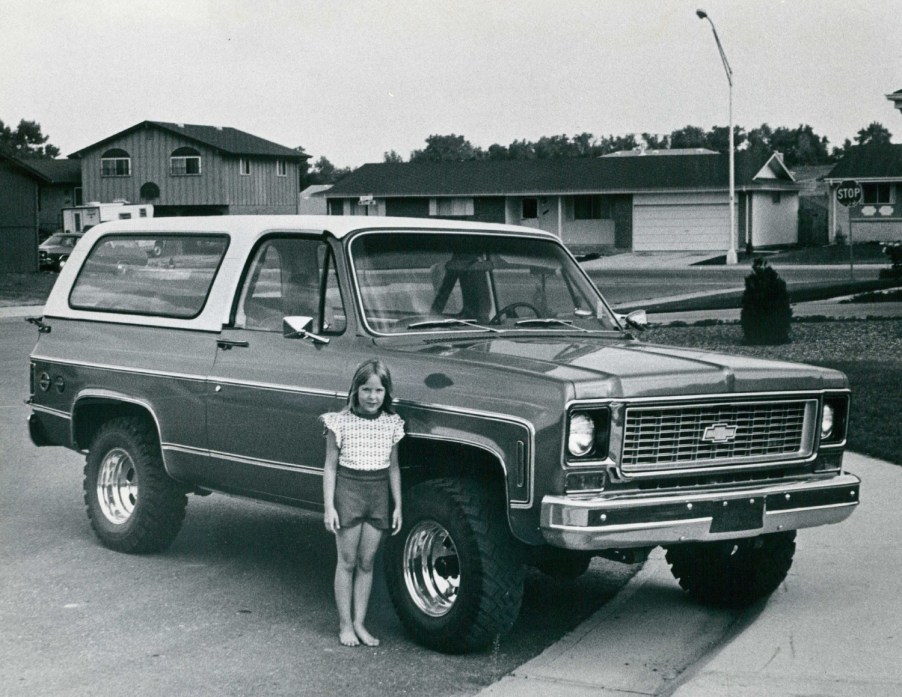
History of the Chevy Blazer SUV: From Convertible to Electric SUV in 55 Years
The Chevy Blazer, or Chevrolet Blazer as you might also know it, has been around since 1969. As a full-size sport utility vehicle, the Blazer has undergone many changes. Most recently, Chevrolet released the all-electric Blazer. What is the history of the Chevy Blazer SUV, and how did it get to its next all-electric form?
The history of the Chevy Blazer SUV starts in 1969 as a full-size vehicle

The first-gen Chevy Blazer was on the market from 1969 to 1972. This is probably the version most people think of when referring to the quintessential Chevrolet K5 Blazer. Autoblog says Chevrolet considered this a full-size, truck-based Blazer, capable of towing and moving the entire family. The wheelbase measured 104 inches, and the entire vehicle was 177.5 inches long. Chevy offered the Blazer truck with a removable fiberglass top, making it a full-size, convertible truck-based SUV. What’s not to love?
Old Car Brochures says Chevy offered three engine options: a 250-cubic-inch inline-six, a 307 V8, or a 350 V8. Buyers could opt for a manual transmission (three or four-speed) or a three-speed automatic.
From 1973 to 1991, the Chevy Blazer SUV went through a lot of changes
The second generation was also the longest-running Chevy Blazer, from 1973 to 1991. Chevrolet again based it on the full-size pickup truck, but both received a redesign. The roof was removable, and the body was almost seven inches longer, bringing it to 184.4 inches. The engine choices improved, and Chevrolet offered a 400 V8. When 1990 rolled around, Chevy offered a fuel-injected 350 with a four-speed automatic.
The history of the Chevy Blazer SUV took a bit of a turn when the third generation started in 1992. When 1995 rolled around, Chevrolet decided to drop the Blazer name and went with Tahoe instead. It no longer had the recognizable two doors and removable roof. Plus, it grew in size to be 187.7 inches long. The full-size Blazer SUV, now a Tahoe, stopped production in 1999.
Chevy introduced the S-10 Blazer as a different kind of sport utility vehicle
The Chevy SUV took another form in the S-10 Blazer from 1983 to 1994. This version was a bit smaller, based on the S-10 pickup truck that was popular at the time. It was also a body-on-frame construction, and buyers could opt for four-wheel drive. Chevrolet offered it with two doors to start like its big brother Blazer.
The S-10 Blazer was only 100.5 inches long at the wheelbase and 170.3-inch long body; it was smaller than the original. In 1991, a four-door version hit the market but was still smaller than the full-size Blazer. The roof remained fixed in place, likely for safety reasons.
Chevrolet offered a bunch of different engines over the years. Some V6 options, and later on, some fuel-injected engines were an option. The V6 was on its way out for the final years of this generation in 1993 and 1994.
The second generation S-10 saw a lot of changes
From 1995 to 2005, another generation of Blazer lived to see the day. The SUV was mostly following the S-10 pickup truck’s moves, making it easier to outfit both vehicles. Chevy offered it with two or four doors, and the wheelbase was similar to previous years.
Technology was moving rapidly, and thus, so did the Blazer. By 1997, the sport utility vehicle used more of a conventional hatchback, and the split tailgate went away. Full-time all-wheel drive was available, and eventually, the ZR2 trim was perfect for off-road fanatics. The Chevy Blazer was all grown up with upgraded springs, shocks, axels, and other bits.
The modern-day Blazer is a midsize SUV and, in 2024, will return as an EV
In 2019, Chevrolet revived the Blazer nameplate and slapped it on a midsize crossover SUV body. It had two rows, front-wheel-drive, and shared very little with the Chevrolet Blazer it started as. The midsize SUV uses unibody construction, and buyers can opt for all-wheel drive. A 2.5L four-cylinder engine with 193 hp or a 2.6L V6 with 308 hp was an option. The Blazer will return for 2023 with a 2.0L four-cylinder with 228 hp and some refreshed styling.
But like all good things, the Blazer is getting the electric vehicle treatment. The 2024 Chevrolet Blazer EV has an estimated MSRP of $44,995 and will go up to $65,955. Chevrolet says this version, the Blazer SS, will be available sometime in fall 2023.
What does the future of the Chevy Blazer SUV have in store? That’s probably to be determined by how well-received the all-electric Blazer sells.



